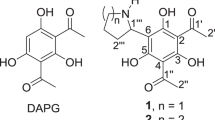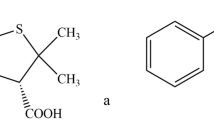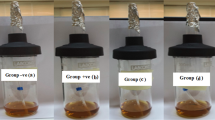Abstract
WHILE preparing and investigating the properties of penicillanic acid (IVa) and its derivatives, we have found that it is possible to separate esters of penicillins and of penicillanic acids by gas chromatography. 6-Chloro-(IIa) and 6-bromo-penicillanic acid (IIa) were prepared by diazotization of 6-aminopenicillanic acid1 (III) in dilute hydrochloric or hydrobromic acid2. The dibenzylethylene-diamine salts, which were used for the isolation of these acids, were transformed into their potassium salts. By hydrogenolysis, in the presence of 10 per cent Pd/C, of the potassium salt of IIa, only partial hydrogenolysis of Ia was observed; in 1 M phosphate buffer at pH 7.6 or in water at a constant pH_ of 8 (a constant pH. was maintained by the addition of 0.5 N sodium hydroxide by means of pH. stat), penicillanic acid (IVa) was obtained in 80 per cent yield. The physical constants of the potassium salt of IVa were: [α]20D + 344 (about 1.0 in water); infra-red bands (potassium bromide disk) at 1,780 (β-lactam) and 1,610 cm.−1 (COO−), and of the cyclohexyl-amine salt: m.p. 161° (dec.); [α]20D + 217 (about 1.0 in water) (all substances reported in this communication gave satisfactory carbon, hydrogen, nitrogen, sulphur and halogen analyses, where appropriate). Penicillanic acid is the basic nucleus of all penicillins3. However, just as with the 6-amino and 6-halogen-substituted derivatives, it is devoid of significant antibacterial activity.
This is a preview of subscription content, access via your institution
Access options
Subscribe to this journal
Receive 51 print issues and online access
$199.00 per year
only $3.90 per issue
Buy this article
- Purchase on Springer Link
- Instant access to full article PDF
Prices may be subject to local taxes which are calculated during checkout
Similar content being viewed by others
References
Batchelor, F. R., Doyle, F. P., Nayler, J. H. C., and Rolinson, G. N., Nature, 183, 257 (1959).
Cignarella, G., Pifferi, G., and Testa, E., J. Org. Chem., 27, 2668 (1962).
Sheehan, J. C., Henery-Logan, K. R., and Johnson, D. A., J. Amer. Chem. Soc., 75, 3292 (1953).
Dow Corning Corporation, Midland, Mich.; see, for example, Vandenheuvel, W. J. A., Haahti, E. O. A., and Horning, E. C., J. Amer. Chem. Soc., 83, 1513 (1961).
Clarke, H. T., Johnson, J. R., and Robinson, R. (eds.), The Chemistry of Penicillin, 93 (Princeton Univ. Press, 1949).
Huang, H. T., Seto, T. A., and Shull, G. M., App. Microbiol., 11, 1 (1963).
Perron, Y. G., et al., J. Amer. Chem. Soc., 82, 3934 (1960). The crude methyl ester was used.
Vanderhaeghe, H., Van Dijck, P., Claesen, M., and De Somer, P., in Antimicrobial Agents and Chemotherapy, edit. by Finland, M., and Savage, G. M., 581 (1961). The crude ester, obtained by reaction of the acid with an ethereal solution of diazomethane, was used.
Sheehan, J. C., and Henery-Logan, K. R., J. Amer. Chem. Soc., 84, 2983 (1962).
Author information
Authors and Affiliations
Rights and permissions
About this article
Cite this article
EVRARD, E., CLAESEN, M. & VANDERHAEGHE, H. Gas Chromatography of Penicillin and Penicillanic Acid Esters. Nature 201, 1124–1125 (1964). https://doi.org/10.1038/2011124a0
Issue Date:
DOI: https://doi.org/10.1038/2011124a0
This article is cited by
-
Einsatzmöglichkeiten der Massenspektrometrie bei der Überwachung von Lebensmitteln und Bedarfsgegenständen. II
Fresenius' Zeitschrift für analytische Chemie (1979)
-
Somatic hybridisation of Penicillium roquefortii with P. chrysogenum after protoplast fusion
Nature (1976)
Comments
By submitting a comment you agree to abide by our Terms and Community Guidelines. If you find something abusive or that does not comply with our terms or guidelines please flag it as inappropriate.



